These nine best substitutes for turmeric spice up your dish and undoubtedly enhance your cooking skill whenever running out of turmeric in the kitchen. The alternatives in my list would be an excellent addition to replace turmeric in terms of both flavor and color.
Turmeric is actually a hard-to-replace ingredient due to its unique aromatic, bitter spice and vivid color adding to recipes. Luckily, there are still a few spices closely the same as the real ingredient, which does help if you are in a jam.
To substitute turmeric appropriately, you should consider which aspects of turmeric your recipes call for. Is it the lovely orange color or warm pepper taste? This process may be a little challenging because you need more than just one backup option to replace turmeric comprehensively.
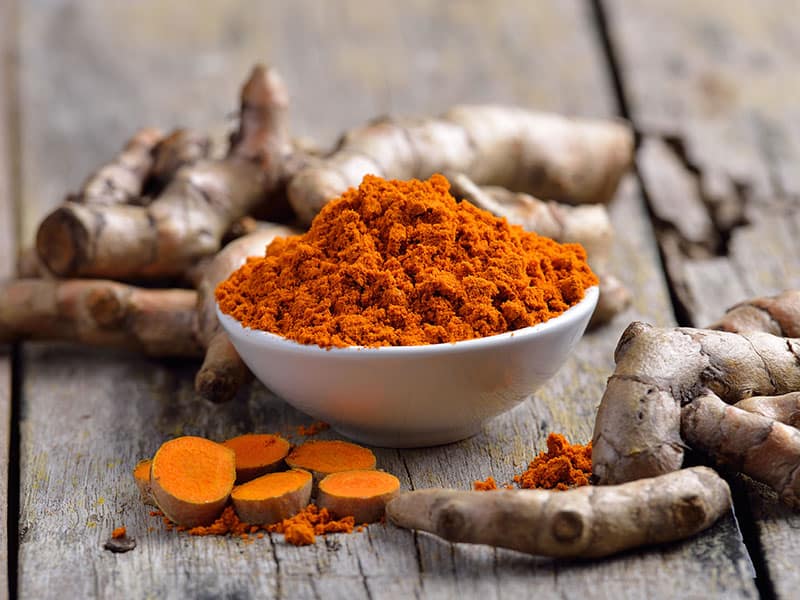
Table of Contents
What Are The Best Substitutes For Turmeric?
A real quick answer to your question is here. To obtain better results while substituting for turmeric, you’d like to scroll down and get detailed information and tips below.
- Saffron
- Annatto
- Paprika
- Yellow Mustard
- Ginger
- Galangal Powder
- Garam Masala
- Curry Powder
- Cumin
What Is Turmeric?
Turmeric is a herbaceous plant belonging to the well-known Ginger family. It is native to tropical India, and India is also the leading producer of turmeric. These plants are harvested annually for their underground tubers.(1)
When not used immediately, the tubers are boiled for 30 to 45 minutes and then dried in a hot oven. They are then ground into an orange-yellow powder that is commonly used as a seasoning in cooking.
Turmeric is featured by a slightly hot, slightly bitter, mustard-like taste and a distinct earthy aroma. This ingredient is popular in Indian, Middle Eastern, and Asian cooking as a kitchen spice. In the United States, people don’t often have fresh turmeric on their pantry shelves. They’d rather add turmeric powder than fresh ones in their cooking.
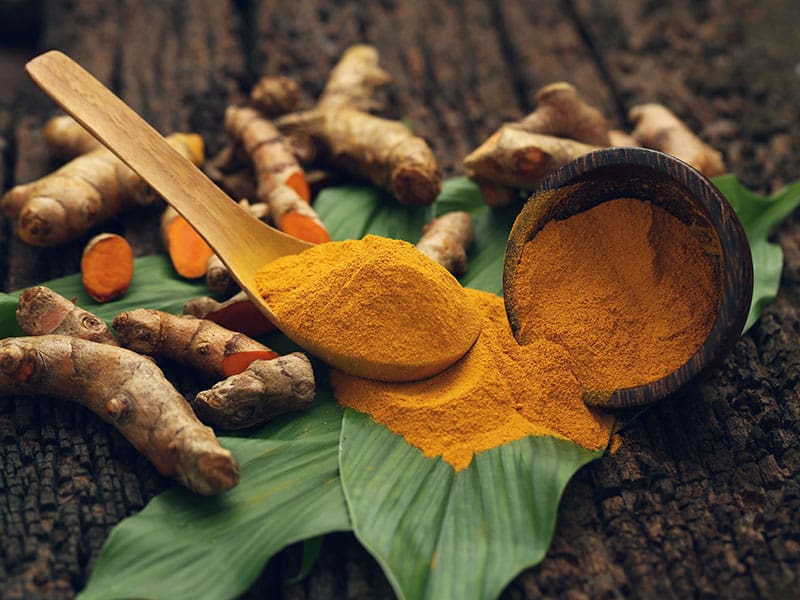
Health Values
Curcumin is the main active ingredient in turmeric. Curcumin is a compound with good antioxidant and anti-inflammatory effects. Therefore, people often use turmeric as an antiseptic for wounds, burns, and bruises.(2)
Taking turmeric in your meals or applying a turmeric mask also helps to beautify the skin. Moreover, turmeric is also a traditional medicinal herb to support digestion, relieve pain, and so on due to the host of curcumin being.
If you are interested in the health benefits of turmeric, a holistic nutritionist shares how to boost turmeric absorption in this video.
Uses
It is one of the main ingredients in Asian cuisine as a flavoring and coloring agent. The rich addition of turmeric adds vibrant yellowish-orange color to curries, rice, marinades, soups, baked goods, sauce, and beverages.
Due to a particular set of health benefits, turmeric is used in traditional and folk medicine as well as in modern pharmacies. It also features as a coloring agent in food processing and textile and a critical element in spiritual ceremonies.
Perfect Turmeric Substitutes
I bet turmeric substitutes are helpful. You are excited because you’ve discovered a delicious curry recipe and want to try it immediately. Unfortunately, all the turmeric in the kitchen is gone; what to do next? Don’t worry. My list of best turmeric substitutes will comfort you.
In fact, turmeric imparts vivid orange-yellow color and specific pungent, bitter spice, which are challenging to replace perfectly. Before jumping into cooking, you may need to ask yourself an initial question: What role turmeric plays in this recipe?
I bet you do not want to mess with recipes where the rich flavor of turmeric is the soul. However, there are still various dishes that give you the freedom to create the replacement of this unique spice. Some substitutes often mimic only one of the turmeric’s features. Then all you need to do is combine some suitable alternatives to get the satisfying back-ups.
The Best Turmeric Substitutes For Color
Searching for a coloring agent to garnish dishes with a vibrant yellow shape as turmeric does? This section will help you figure out some nice turmeric substitutes for color.
1. Saffron
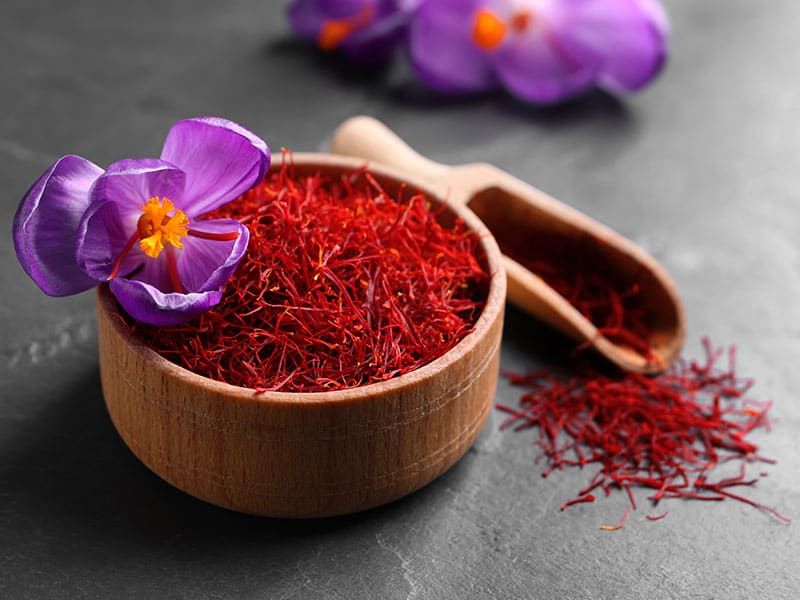
Saffron is the pistil of the saffron plant. This plant is distributed mainly in Eurasia, North Africa, North America, and Oceania.
Saffron is an excellent backup for turmeric. Saffron won’t be an ideal substitute in terms of flavor. However, saffron can perfectly imitate turmeric’s bright color. Saffron actually has a red appearance. While marinating foods, this ingredient will create a yellow-orange color.
This substitute has quite a different taste from turmeric. You should use a small amount of it to save you from messing up the recipes. You can also serve saffron in a drink; just make sure you find a pleasant green tea to have an excellent drink for a rainy day.
Saffron is known as the “golden spice”, “aristocratic spice” because it is the most expensive spice globally. Saffron has no reproductive function, and the process of making this spice is entirely handmade. The scarcity of this spice makes its use quite luxurious, and it is also pretty challenging to find.
Saffron may cause increased macular degeneration in patients with diabetes. These people should take notice of this ingredient.
2. Cumin
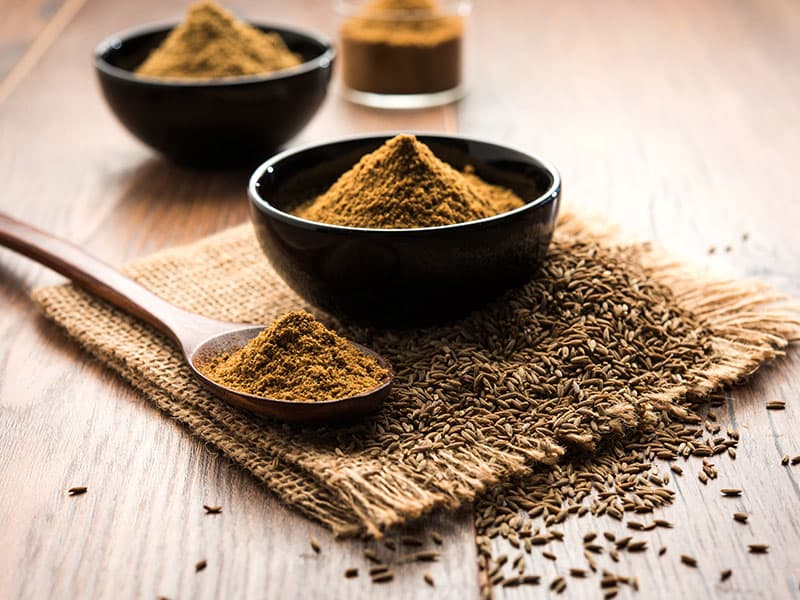
Cumin is native to the Mediterranean basin. This is a spice that makes up the soul of Oriental cuisine. Cumin is made by finely grinding the seeds.
Cumin has a tremendous effect on flavoring and coloring, suitable for many types of processing materials. Cumin’s pungent savor is used as the main spice in Indian, Mediterranean, Latin American, Middle Eastern, and African dishes.
In the Middle East, dishes such as curries, salads, tacos, enchilada will be indispensable with cumin seasoning. Instead of turmeric, adding cumin in tasty salmon patties is just as great. You may love affordable canned salmon more than fresh products if you don’t have time for a sophisticated food process.
Cumin not only adds flavor to the dishes, but cumin is also a kind of “panacea” that provides a wide range of health values. Cumin powder can be used to treat gastrointestinal diseases such as diarrhea, indigestion, and flatulence. Cumin helps to treat hoarseness and stimulates taste. It is also helpful for people with anorexia.
3. Annatto
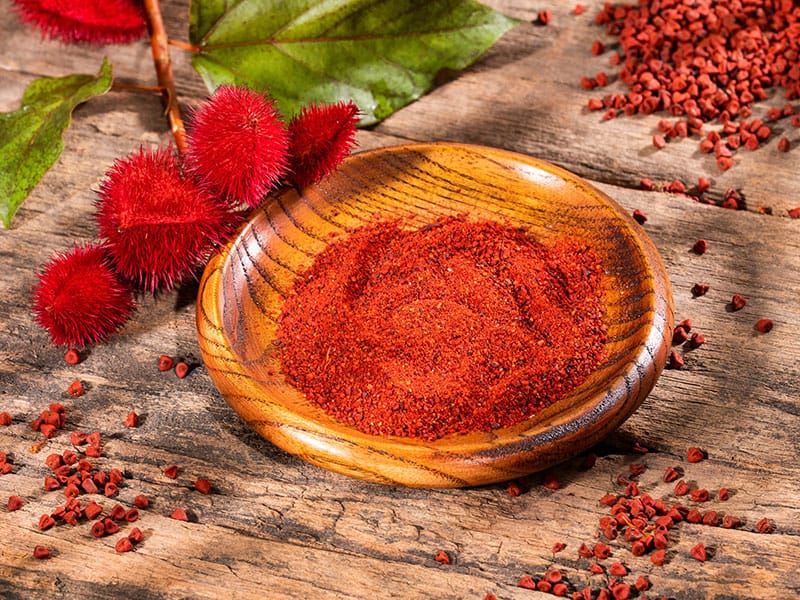
Annatto is an orange spiced food made from the seeds of the achiote tree, which grows in tropical regions of South and Central America.
Although it may not be well known, an estimated 70% of natural food coloring is derived from it. Therefore, if you are chasing the intense orange-yellow color, Annatto can do a fantastic job.
However, Annatto’s flavor is quite different from real spice due to its peppery, sweet, and nutty taste. Annatto works best in starch dishes, marinades, sauces, and casseroles.
Annatto has been related to numerous health benefits, relieving heartburn, decreasing irritation, and excessive blood pressure.
In general, Annatto seems to be safe for most people. Some people uncommonly experience an allergic reaction, especially if they already have a known allergy to plants in the Bixaceae family.
But if you want, you can still add this vibrant color to any recipe, from sweet cakes to chicken stews. Watch this video and enjoy the mouth-watering look of grilled chicken thighs with an annatto marinade.
4. Yellow Mustard
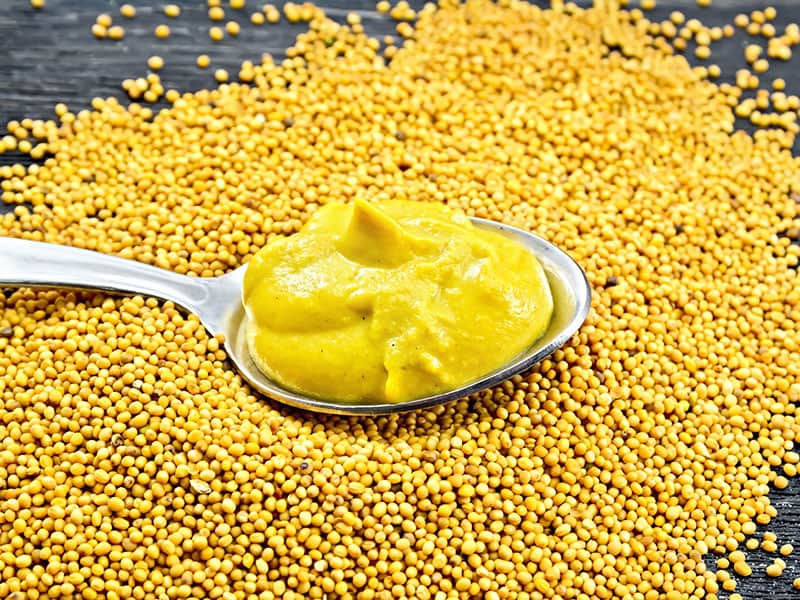
Yellow mustard was the main spice that got used to create the aroma in ancient European cuisine. It is favored until now. American love this mustard and serve it as an indispensable topping for various classic foods.
Although the mustard imparts a mild yellow color that is slightly different from vivid orange turmeric’s one, you should still consider this yellow spice to prepare a lovely meal.
The yellow mustard may not be a cup of tea for some people due to its intense heat of flavor. Therefore, it’s best to use it in small quantities in order not to make a dish that is too hard to swallow.
Yellow mustard is an indispensable condiment for making a salad, marinating foods, and serving with grilled sausages, steaks, kebabs, and bread. It also helps eliminate the unpleasant smell of meat, including lamb and goats.
Other types of mustard, including dijon mustard and spicy brown mustard, would not serve as a choice to replace turmeric.
Excellent Turmeric Substitutes For Flavor
There are still some great backup options that can mimic the pungent flavor of the real stuff. Let’s jump into this part and figure out what can replace turmeric to lend the taste.
5. Ginger
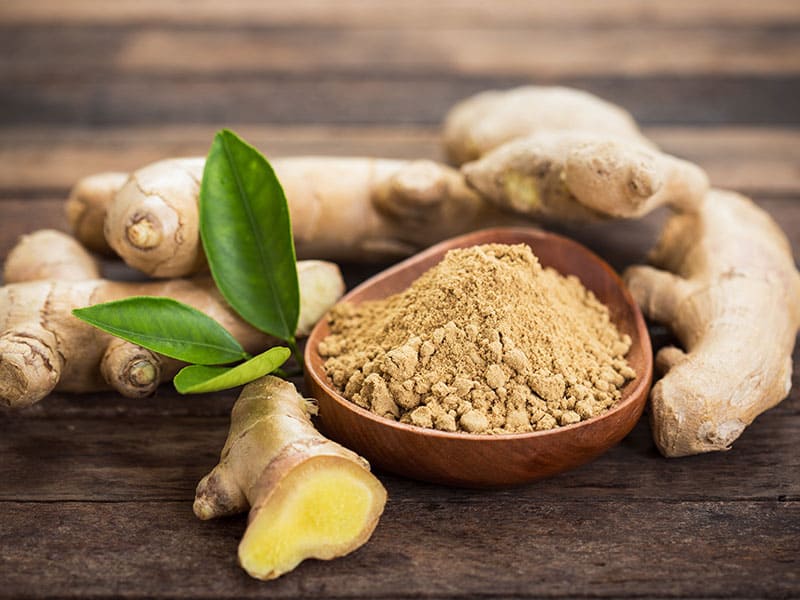
Ginger is a cousin of turmeric in the Ginger family. Ginger is native to Asia, where it has been used as a spice for at least 4,400 years.
Although ginger and turmeric share the same origin, ginger slightly differs. It has a sweet, spicy, pungent flavor which may not taste right in some recipes. Therefore, you need to use it sparingly not to let the differences go too far that everyone can notice.
In cuisine, ginger is often used as a seasoning to help eliminate the undesirable smell of raw foods and increase flavor in many dishes such as soups, curries, and baked goods.
It is also an excellent substitute for turmeric in smoothies and beverages. If you’re used to turmeric tea, you will probably love ginger tea. Just give some exquisite ginger teas a chance.
Ginger has various significant effects on human health and beauty, which is the same as turmeric does. Ginger is an excellent product for the digestive system, which solves stomach and intestinal problems, enhances weight loss, helps clear skin from acne, and protects the skin.
With just a little ingenuity, you can extract ginger powder yourself at home with high efficiency and still meet food safety and hygiene standards.
6. Galangal Powder
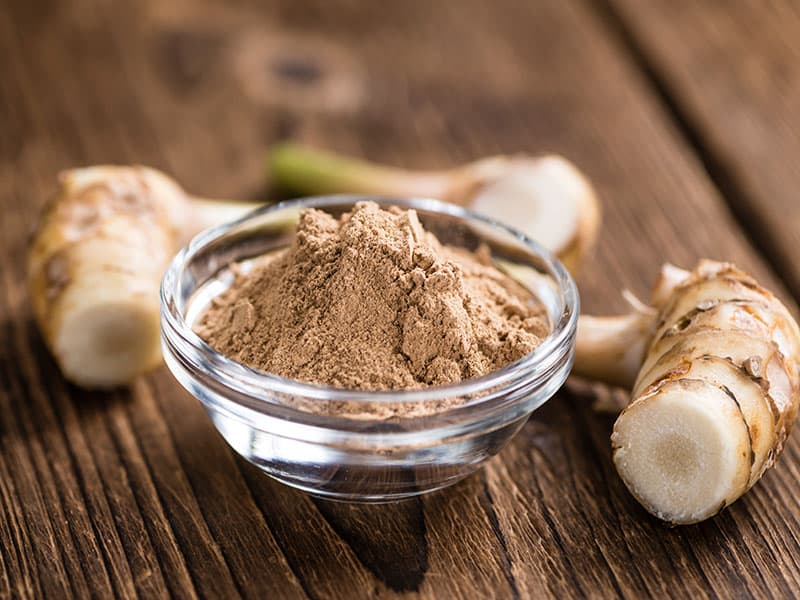
Galangal, another member of the ginger family, is a familiar spice in many Thai dishes. Galangal brings an attractive and distinctive flavor to the plate.
This ingredient won’t boast any vivid color, but it can make up for turmeric due to its spicy, tart taste. Just a little galangal powder can add a nice complement to the soup.
Galangal, along with ginger, is used in cuisine because of its ability to support digestion and eliminate fishy odors of seafood and poultry; well combined with other spices such as basil, chili, lemongrass, cloves, chives, curry powder, and also in cakes.
The effect of galangal has been proven by many scientific studies when used in the treatment of diseases, as well as the habit of using this tuber when preparing dishes.
With a significant amount of antioxidants, galangal becomes food that helps you fight many diseases. Compounds in galangal have the ability to induce cancer cell death, thereby fighting some cancers in humans.
7. Garam Masala
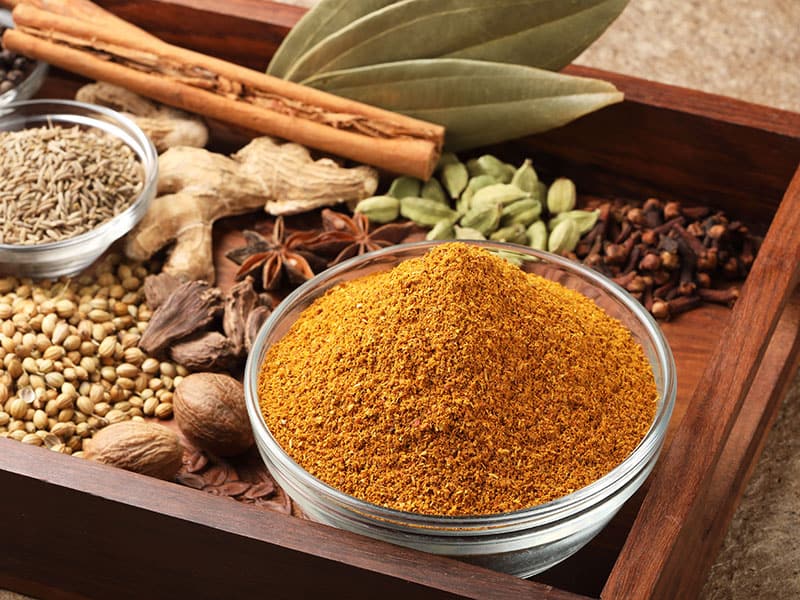
Garam Masala is a spice mainly used in the preparation of dishes in Northern India. Garam Masala can simply be understood as a mixture of hot spices such as black pepper, cumin, cardamom, cinnamon, and cloves.
In fact, there is no standard for Garam Masala recipe that chefs will create depending on personal preferences as well as regional tastes.
Garam Masala is added to dishes long before serving to enhance flavor. Garam Masala is an excellent seasoning for chicken, beef, or seafood. This ingredient performs pretty well in quick curry recipes with nutritional canned sardines.
This is also a pre-processed spice mixture to put in the curry pot, without being too fussy but still creating the typical flavor of Indian curry, giving the impression of a passionate dish as soon as it is cooked. Touching the tip of the tongue and the aftertaste will never fade.
If you can’t find Garam Masala on the market, you may want to thoroughly prepare this spice at home to serve in spicy dishes such as Indian curry, Thai hot pot.
I can smell the savor already from here when watching the lady make garam masala in this video. You would properly love this homemade recipe.
Turmeric Substitutes For Both Color And Flavor
These lovely substitutes in this part can do both tasks: living up the color and boosting the flavor. Try these remarkable options instead of turmeric right now!
8. Curry Powder
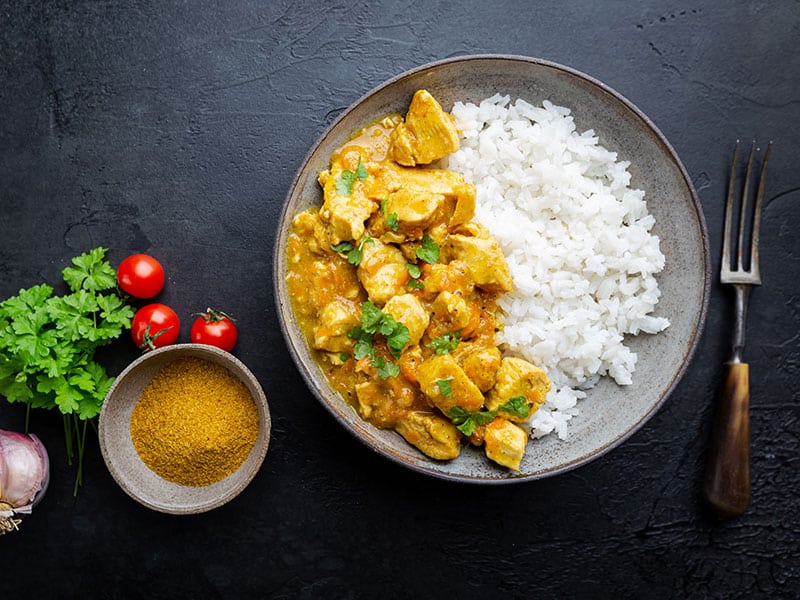
Curry powder is a mix of various spices that give the power a bright yellow color. Its ingredients can include turmeric, cumin, fenugreek, cinnamon powder, etc.
Curry powder contains turmeric, so that it will absolutely add a pleasant color to the dish with a harsh yellow tone. It would be a lovely vivid color agent in your cooking.
Along with turmeric, curry powder also contains various spices; therefore, it tends not to be a perfect choice in some recipes. A wide range of spices makes it a strong-flavor addition. You should reduce the quantity of this ingredient to avoid overly spicy dishes.
When you choose a curry powder that suits your taste, you can add it to dishes such as potato salad, roast, stews, soups.
The powder is rich in anti-inflammatory compounds, and consuming it can help reduce oxidative stress, promote heart health, and improve blood sugar, and a wide range of other potential benefits.
Madras curry powder performs even better than regular curry powder. Let this Indian cook show you how to make madras curry powder accurately.
9. Paprika
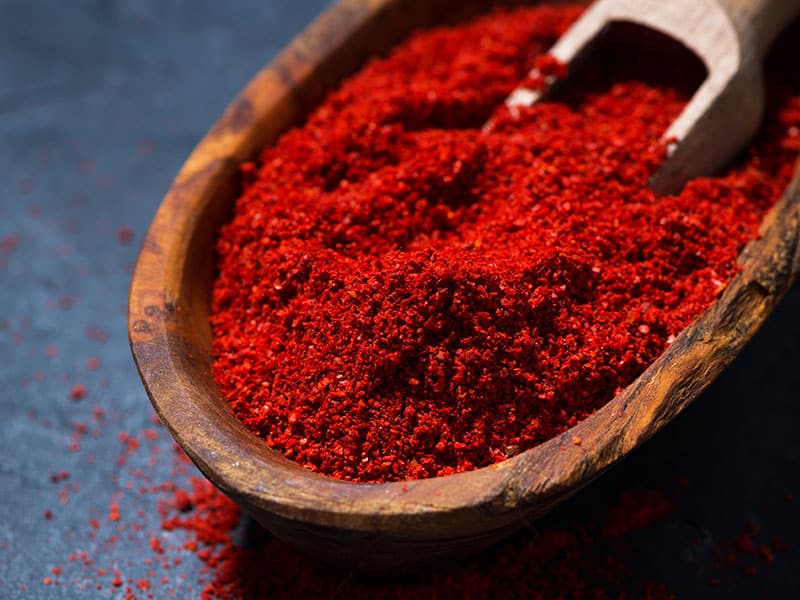
Paprika is a red powder made from bell peppers; it is also made from other chili peppers with pungent properties.
The origin of the Paprika comes from central Mexico, and it was not until the 16th century that the Paprika was transmitted to Spain, Portugal, Turkey, and Hungary. Paprika has become an indispensable ingredient in cuisine. Today, Paprika is one of the most famous spices in the world’s cuisine.
There are three main types of Paprika: sweet Paprika, hot Paprika, and smoked Paprika. You can sprinkle Paprika on top of dishes to create vibrant colors or use it to marinate meats and fish before processing.
Paprika is used as a seasoning in most Hungarian dishes, mainly in stews and soups. If you want to enjoy the traditional Hungary flavor, you can try to put Paprika instead of turmeric in your pasta or casserole recipes with some convenient frozen meatballs to enrich the flavor.
Paprika is not only used as a common seasoning for dishes, but this powder also has particular benefits for users’ health, such as providing vitamins B6, A, E along with many minerals and fiber. Paprika is also beneficial for the digestive system, stimulating the stomach and bile to work properly.
Paprika is not suitable for people with respiratory and stomach problems because this spicy chili powder could take them to see the doctor.
Note: Mace and smoked paprika combination work well as a backup option to substitute turmeric in any savory dishes. They not only lend a pleasant yellowish-orange tinge but also boast a spicy, pungent flavor in recipes.
FAQs
To this point, you would certainly gain some understanding of the topic. Now I’m willing to share some frequently asked questions to clear up your queries.
Expectation Vs. Reality
As I mentioned, turmeric is a particular unique spice. There is a specific set of benefits this ingredient can provide. It adds an exquisite color, spicy, bitter taste, and earth-like aroma. Including turmeric in your diet is a fantastic way to add more nutrient, antioxidant and anti-inflammatory effects to your body.
As a consequence, trying to substitute turmeric is a tough challenge. In fact, there are no substitutes that make up for the absence of turmeric comprehensively.
Therefore, when you want to experience a recipe in which turmeric is the hero with the super-rich turmeric flavor, you should do something else until turmeric comes back in your pantry. In this instance, don’t persist in searching for turmeric alternatives if you don’t want to turn your cooking into embarrassment.
Even so, turmeric can still be replaced by similar ingredients in various recipes. I researched a list of nine close-seconds that you can easily have a suitable option to salvage recipes called for turmeric without any turmeric.
Does the information help you? Do you have any other ways to substitute turmeric in cooking? Don’t hesitate to like, share and comment below to share with me and others your experience!
References
1. En.wikipedia.org. 2021. Turmeric – Wikipedia.
2. Healthcare.utah.edu. 2021. Benefits of Turmeric.

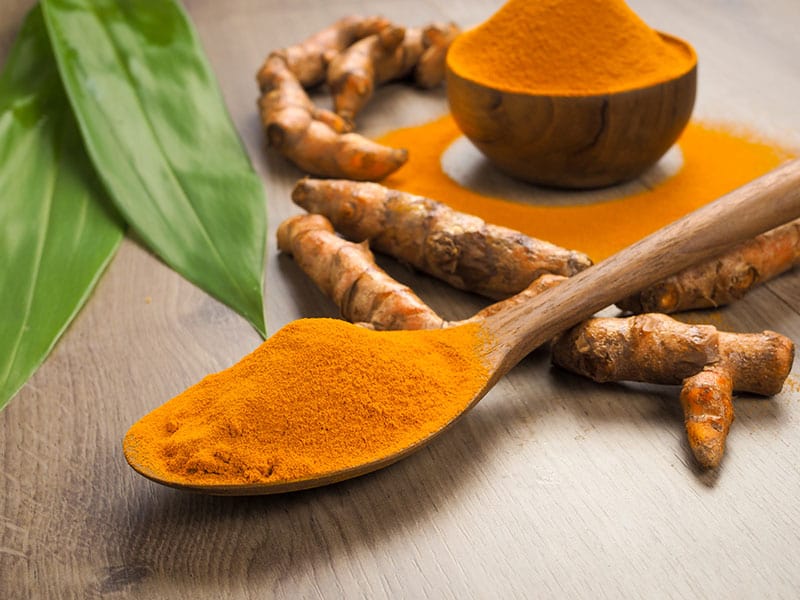
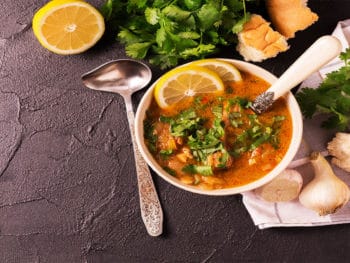
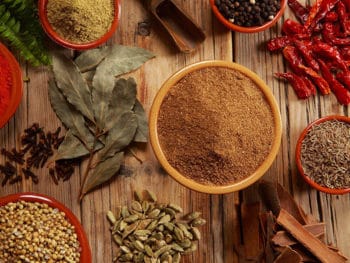
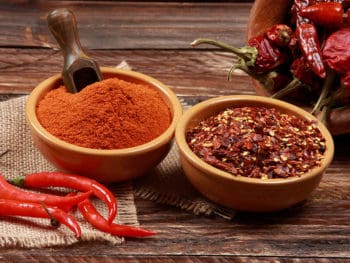
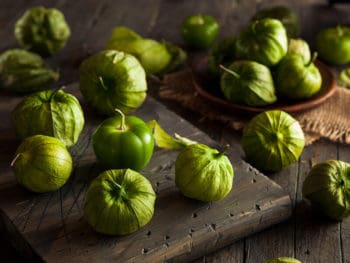
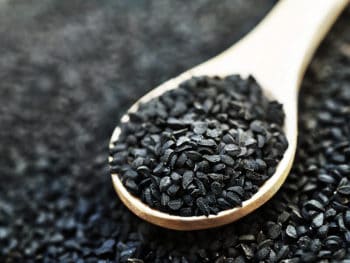

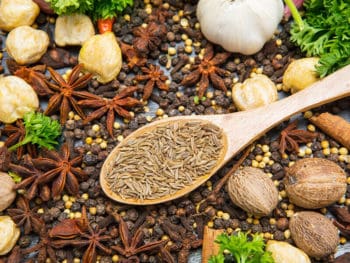
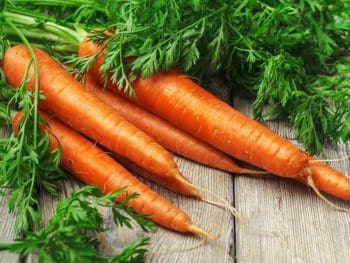
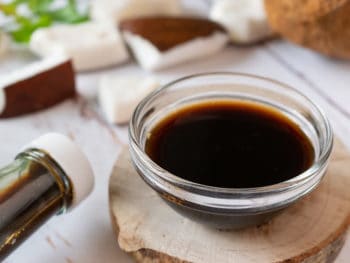
 Coriander Substitutes – 19 Must-Have In Your Kitchen In 2023
Coriander Substitutes – 19 Must-Have In Your Kitchen In 2023